GESTO E SEGNO
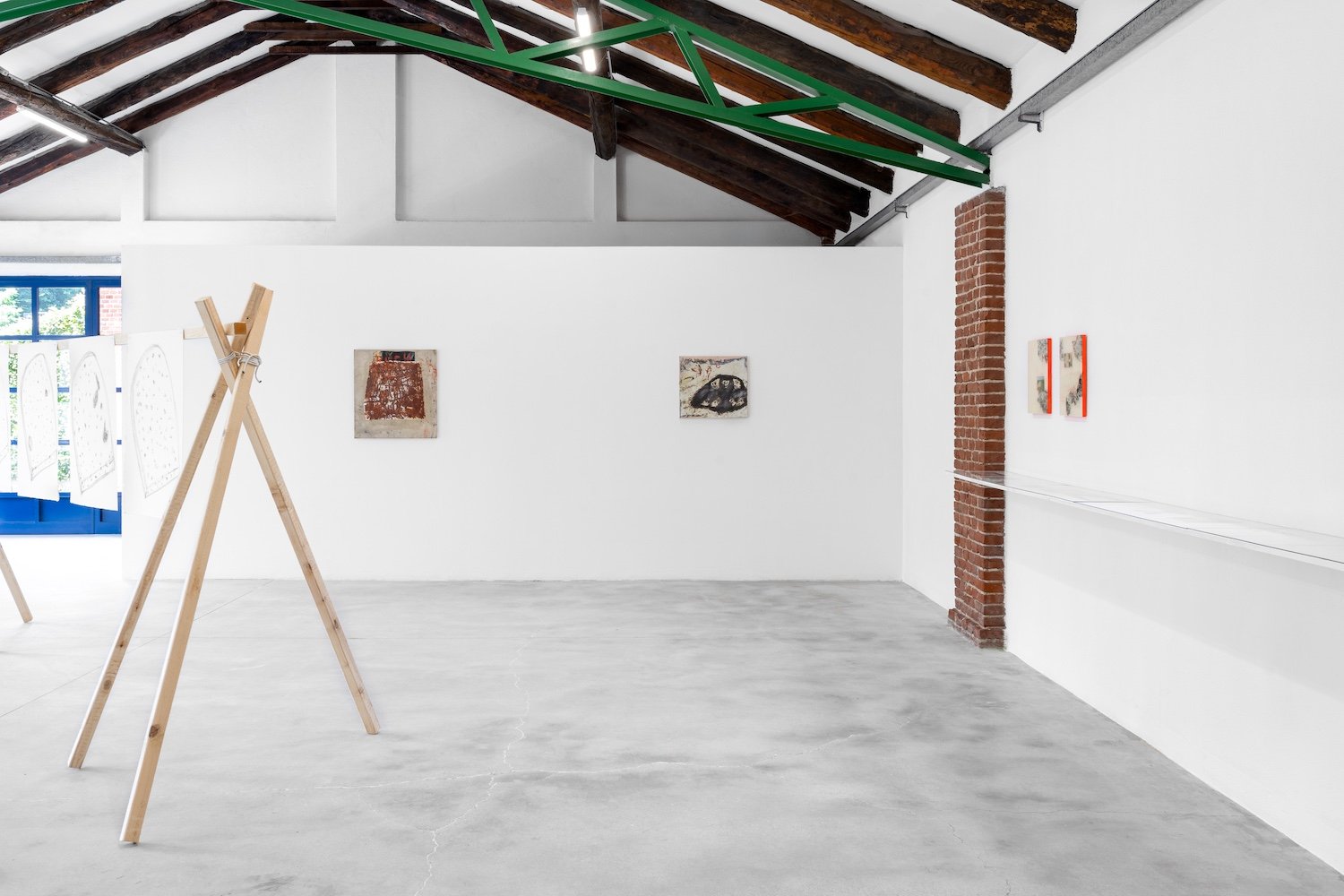
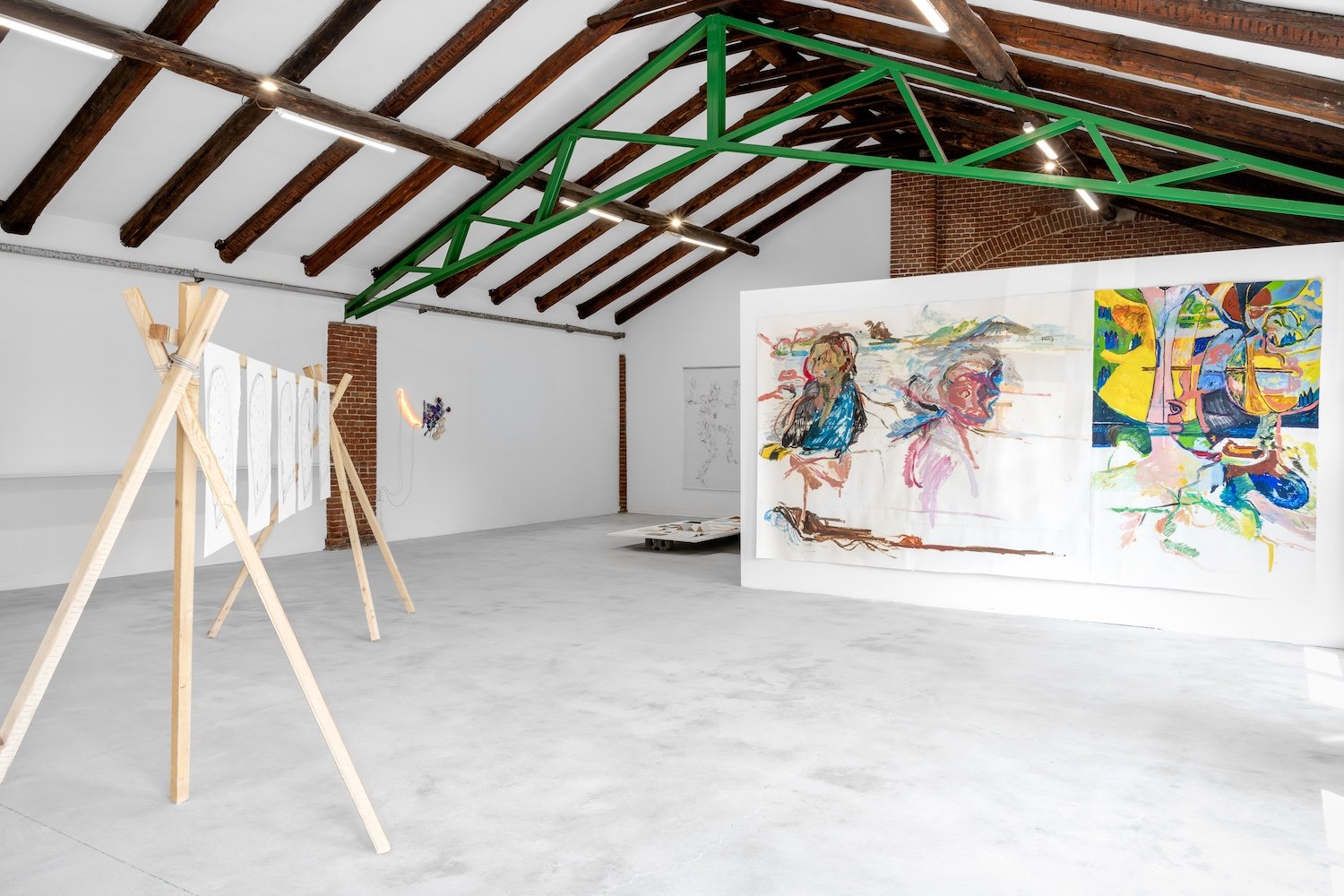
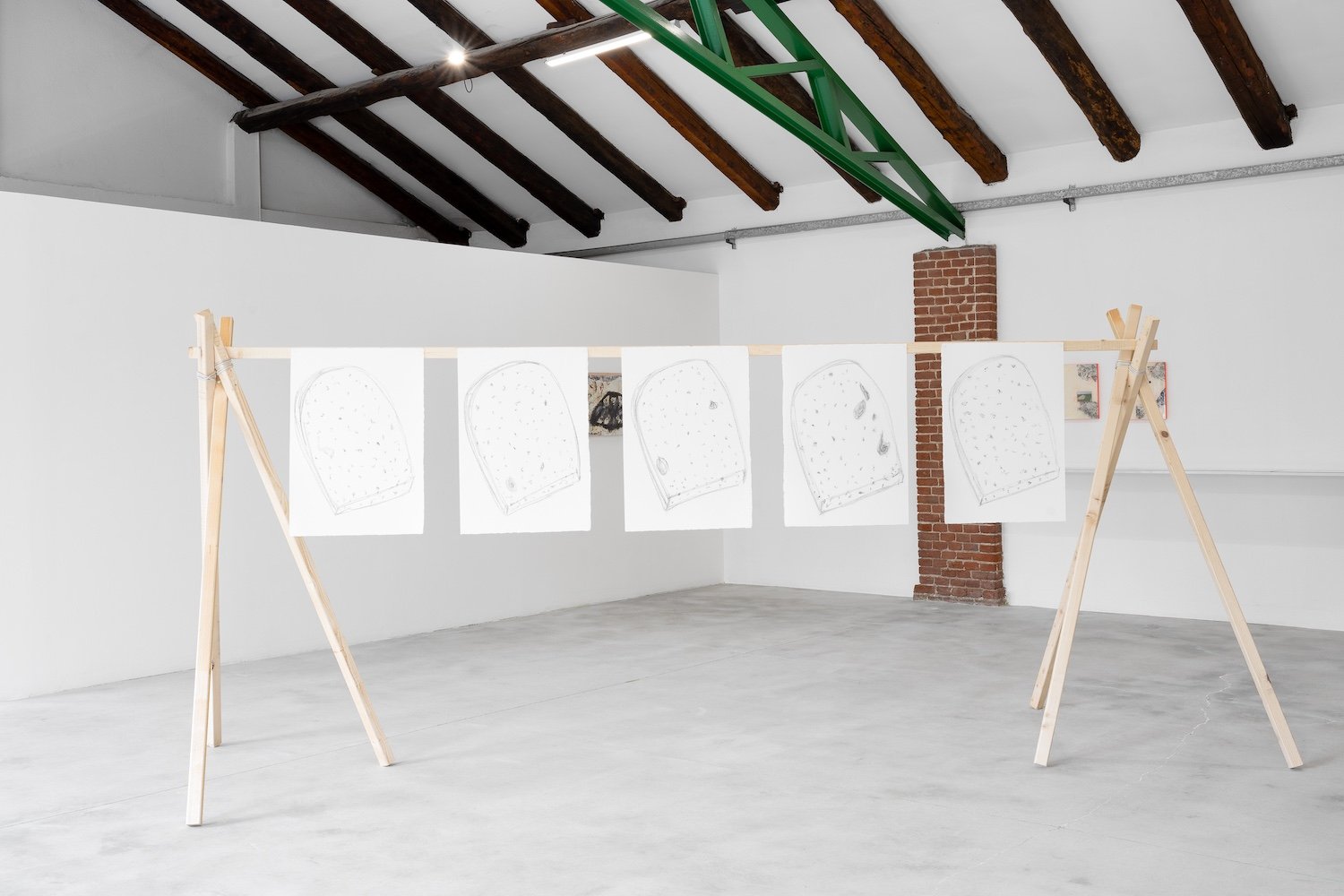
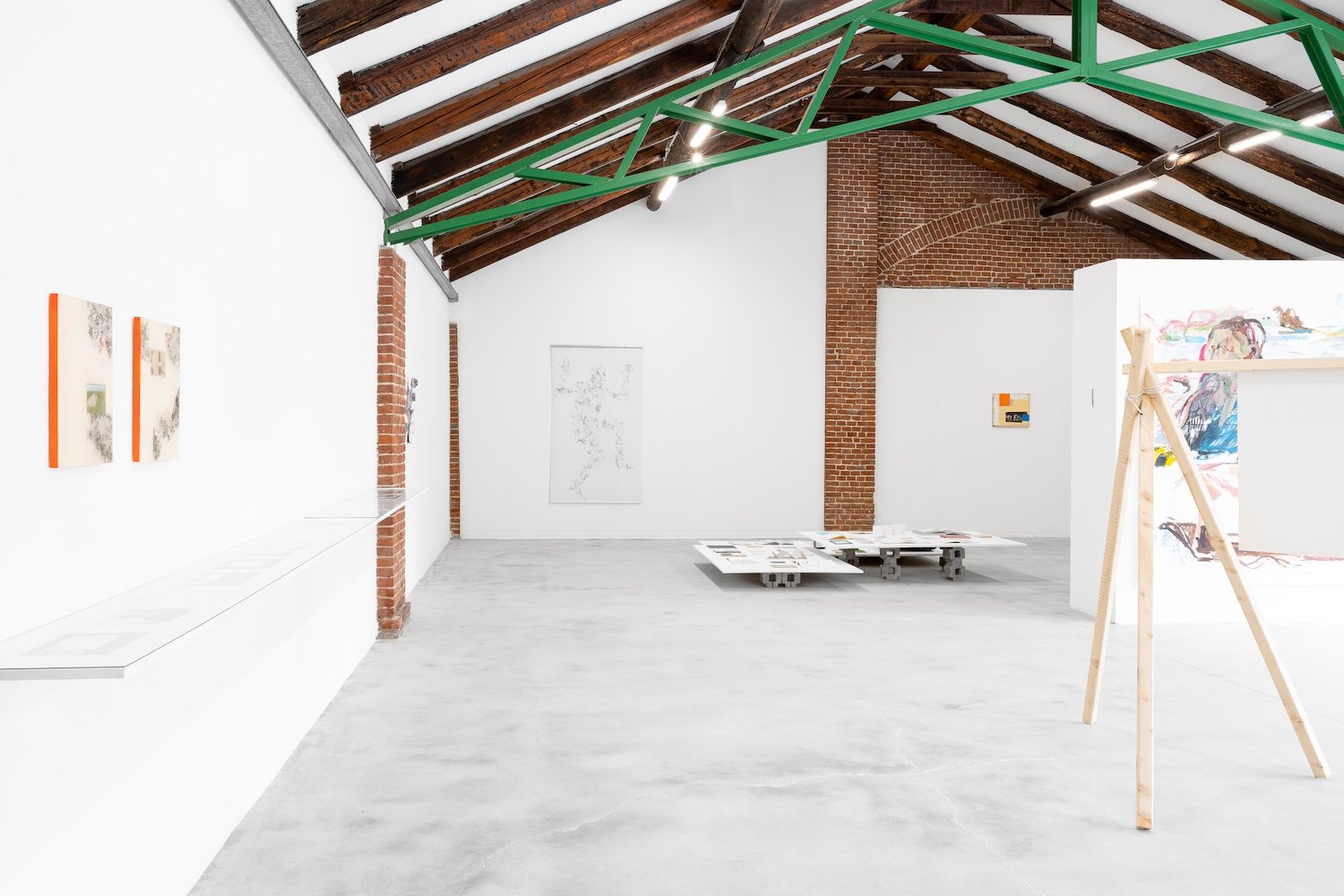
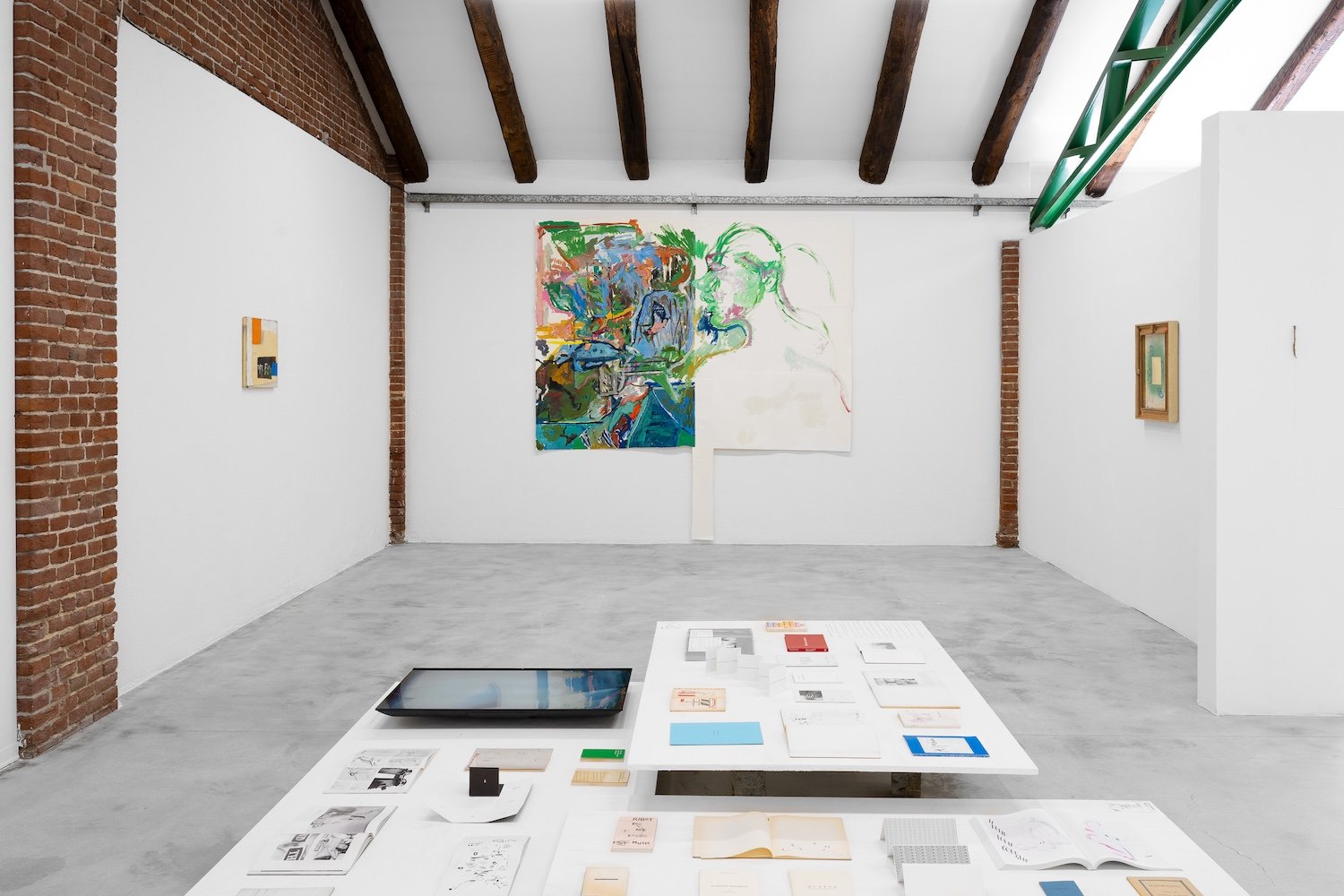
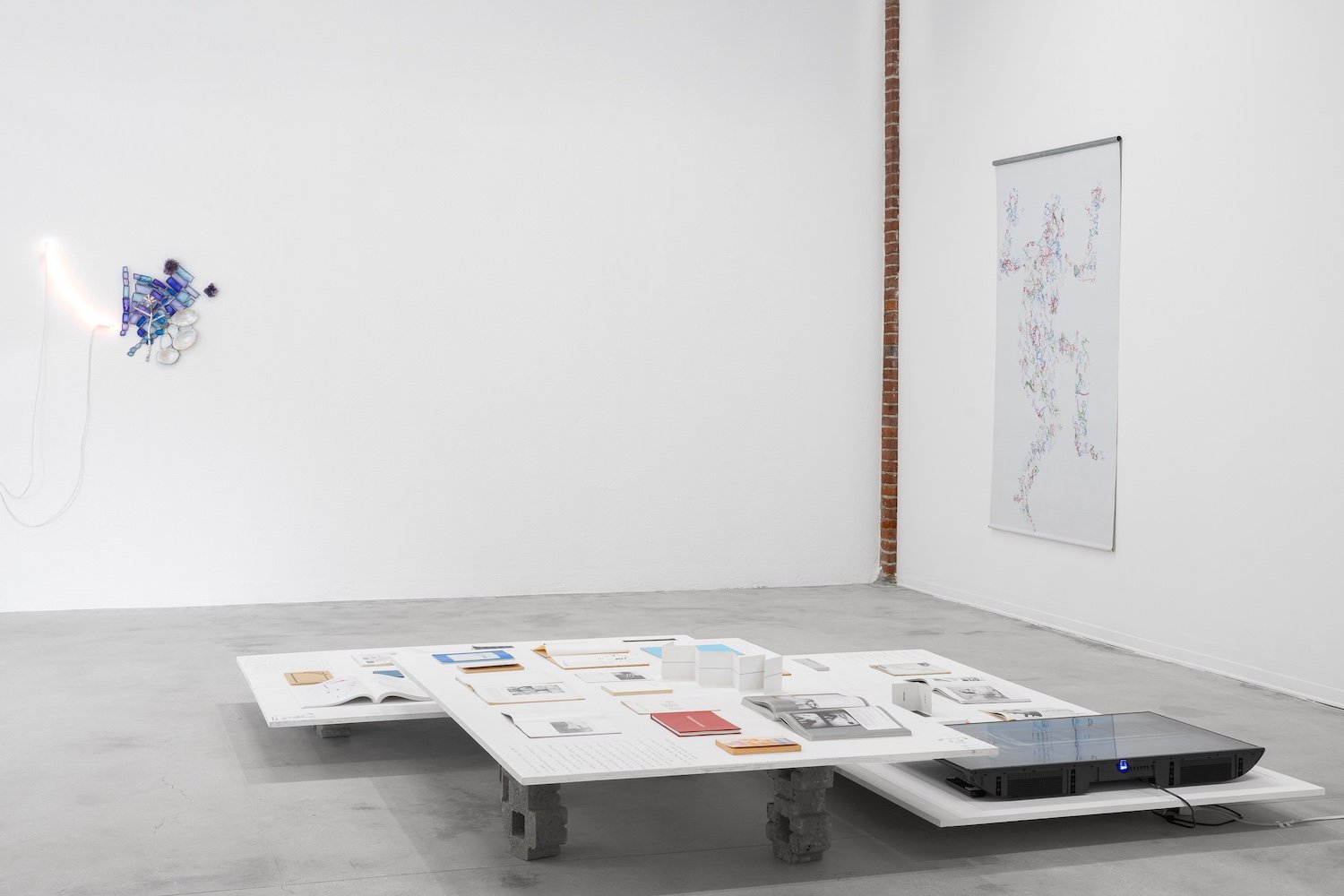
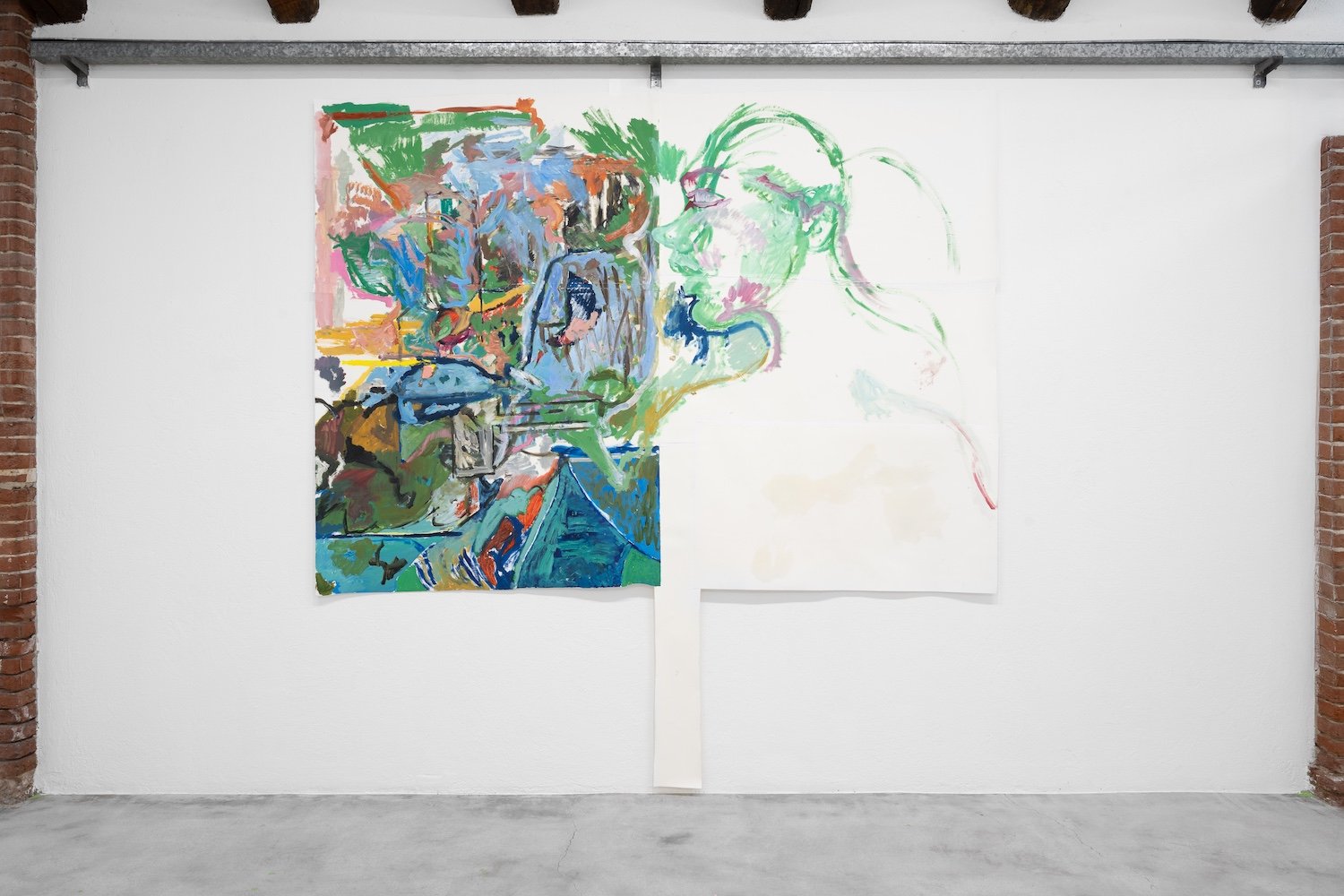
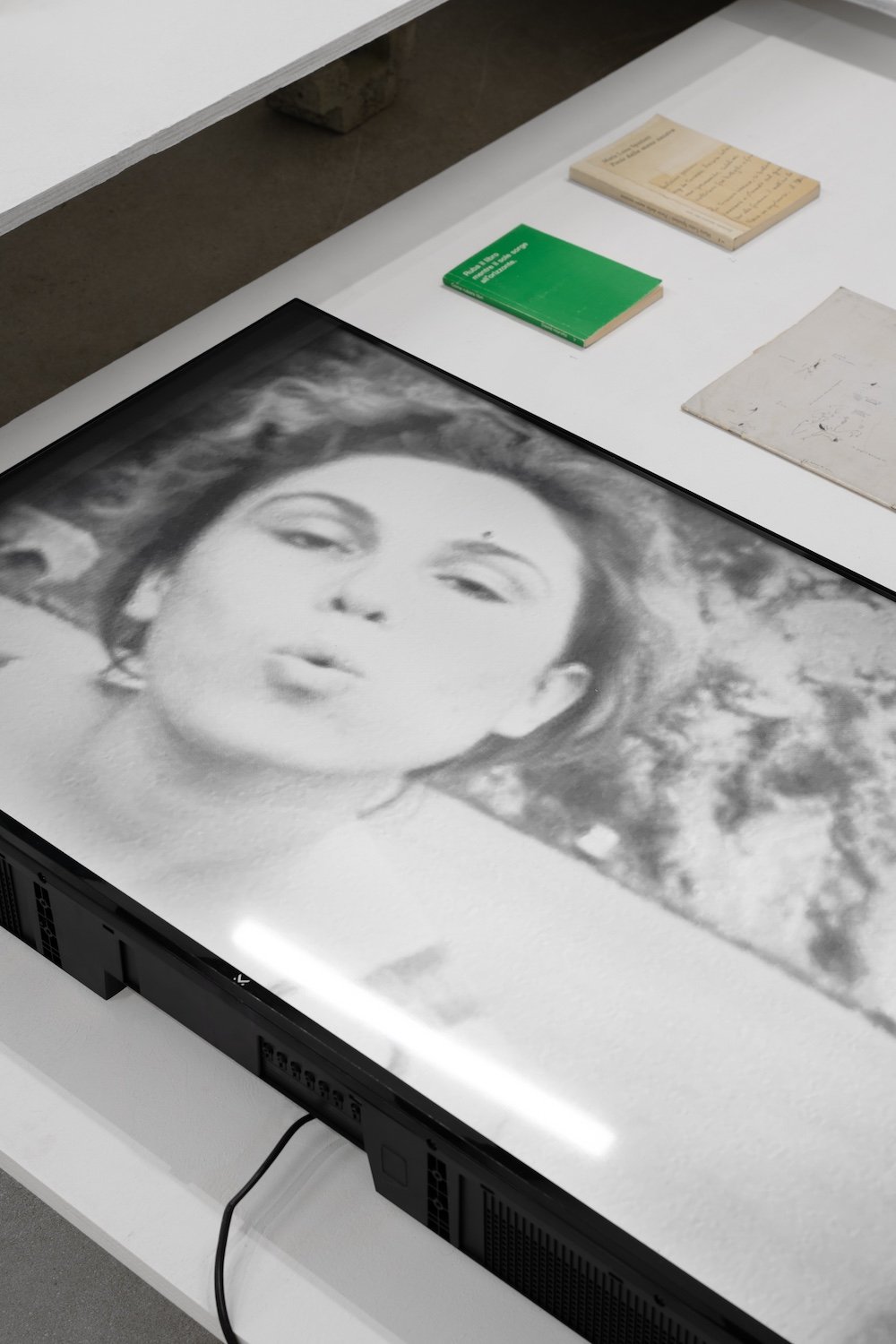

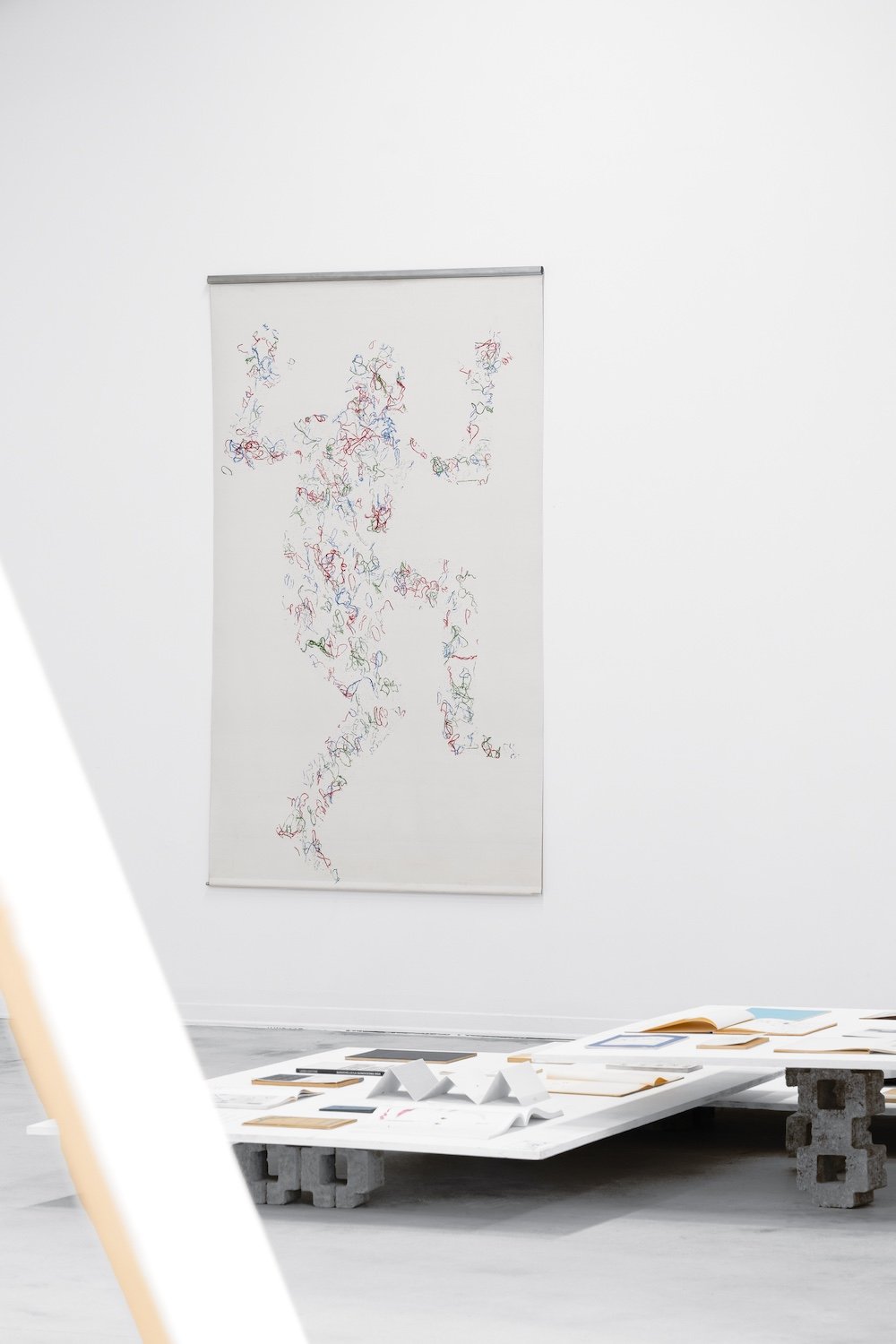

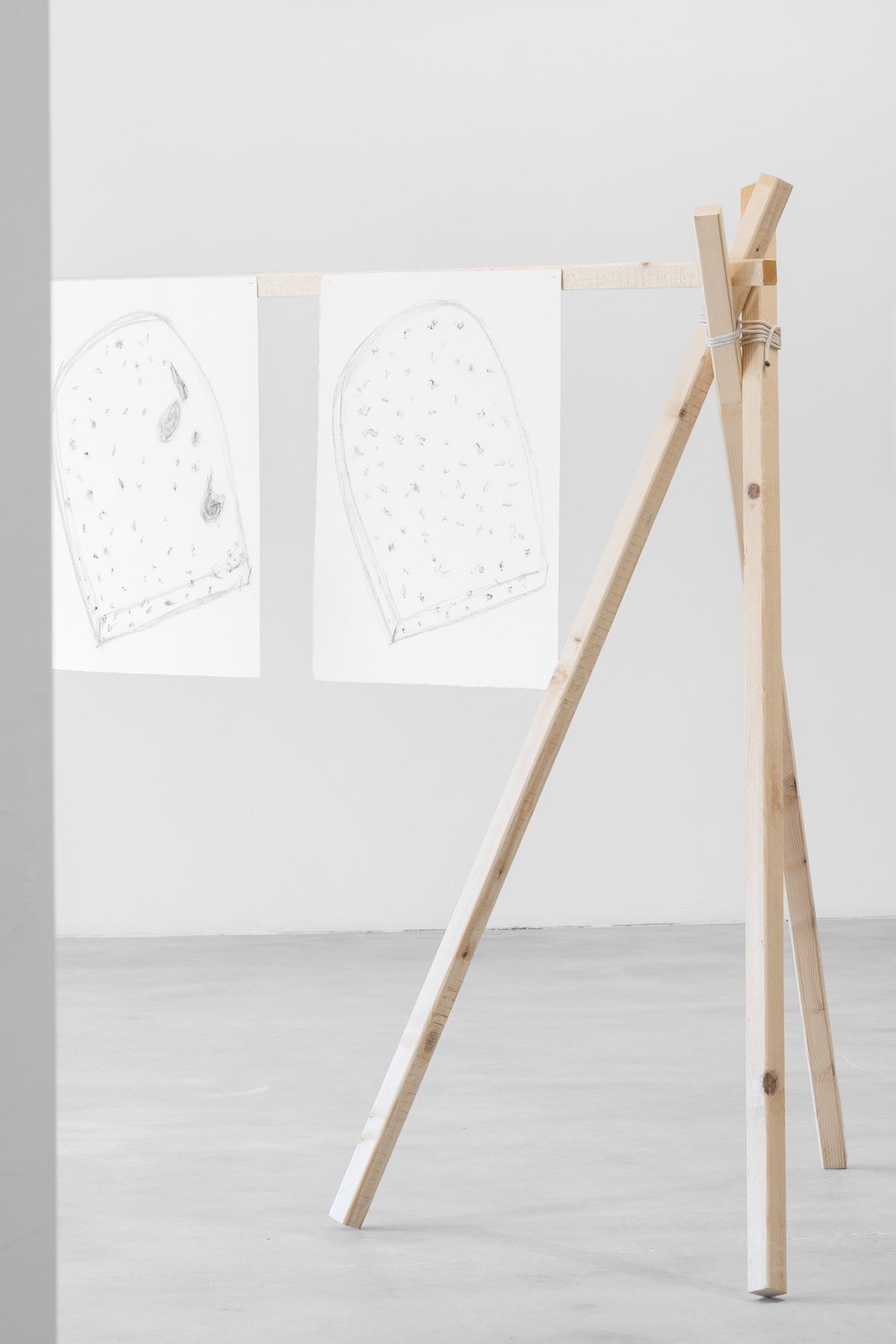
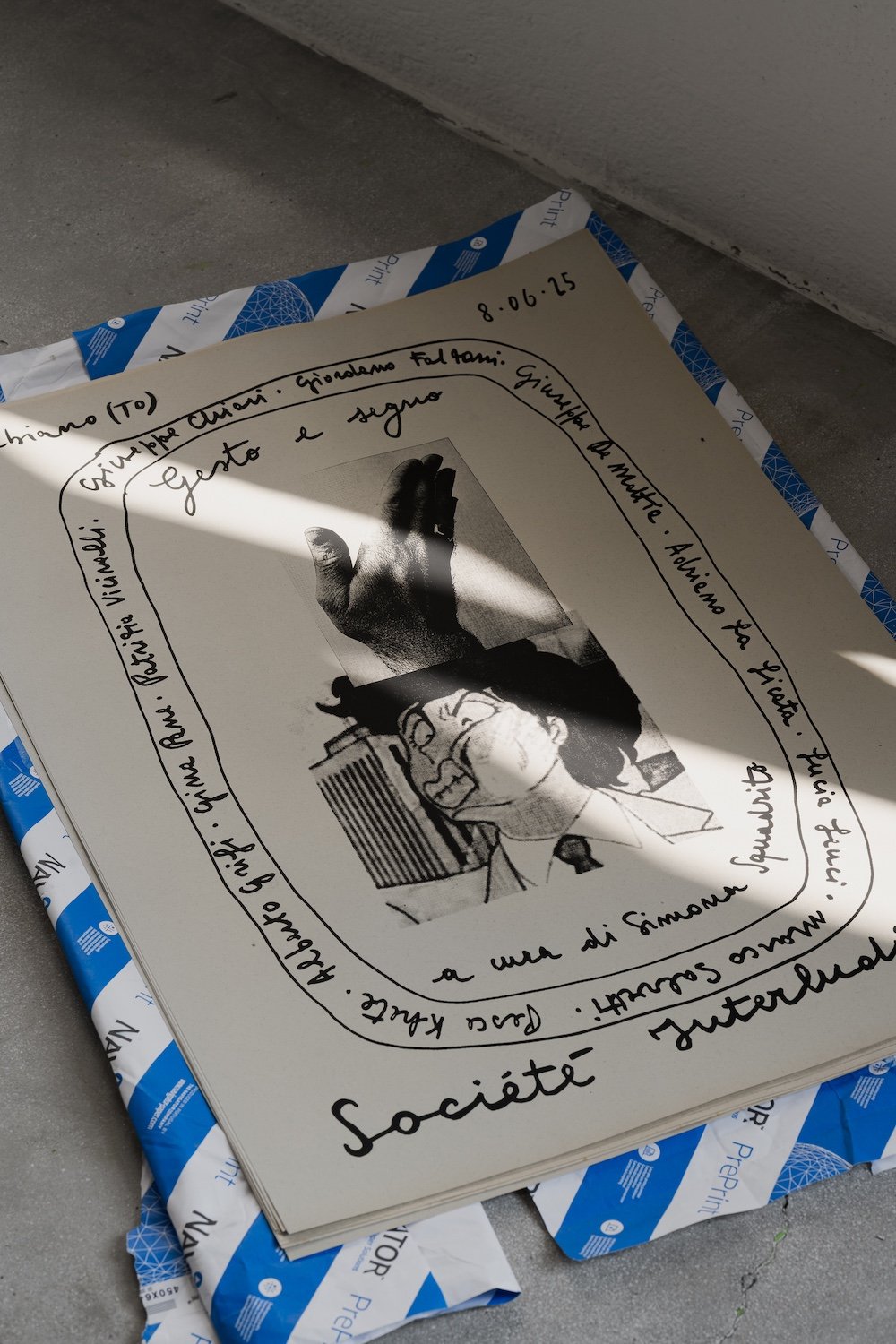
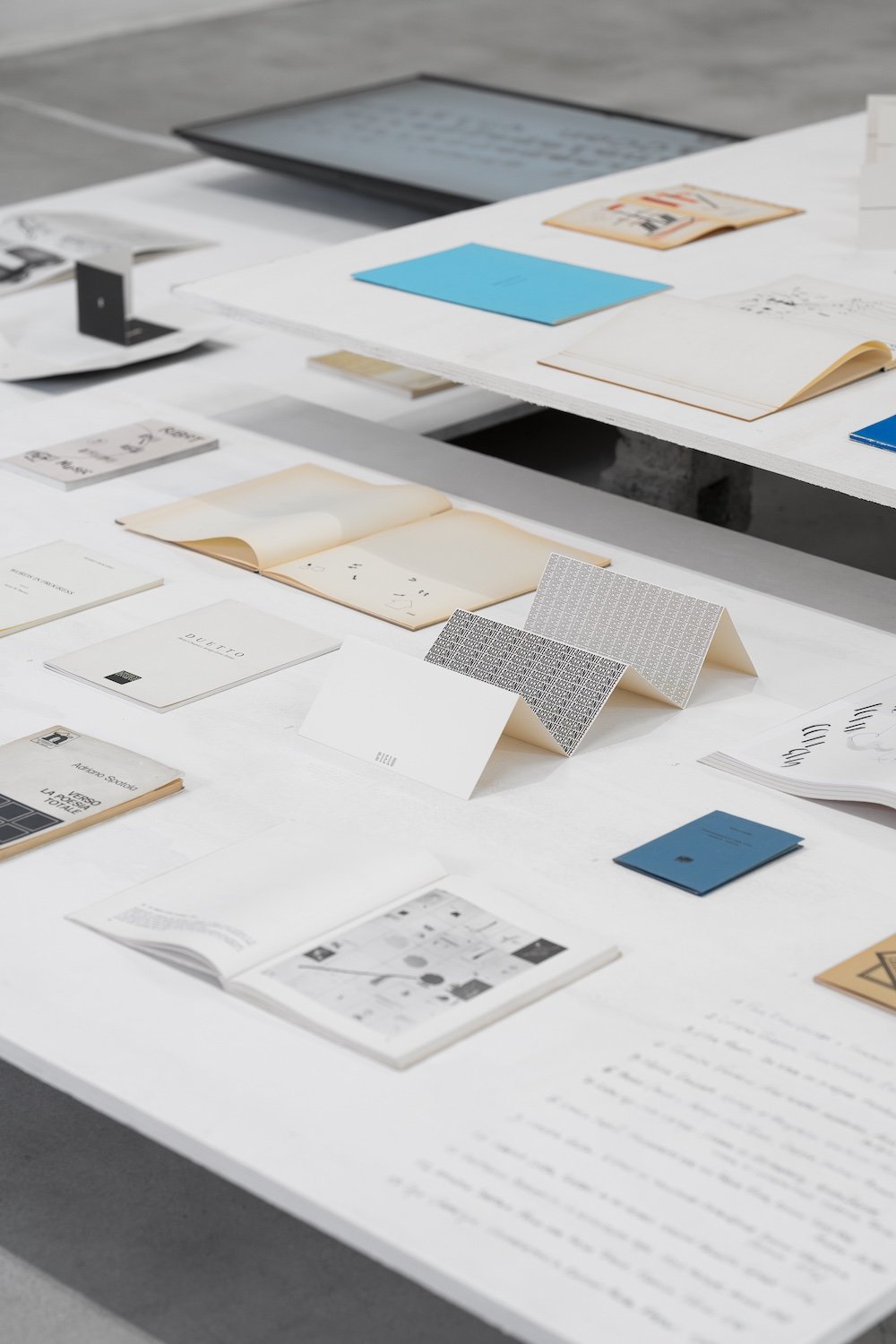
ADRIANO LA LICATA, ALBERTO GRIFI, GINA PANE, GIUSEPPE CHIARI, GIORDANO FALZONI, GIUSEPPE DE MATTIA, PESCE KHETE, LUCIA LEUCI, MARCO SALVETTI, PATRIZIA VICINELLI
Curated by: Simona Squadrito
Opening: Sunday 8 th Jume 2025
Dates: June 9 th — August 31 st
Place: Société Interludio, Cambiano (TO)
The exhibition is realised thanks to the collaboration of: Archivio Grifi (Rome), Tonini Bruno Studio Bibliografico (Gustavo, BS) and REPLICA – Archivio italiano del libro d’artista (Milan)
I must perform a gesture of…
This unfinished sentence, on a folded white sheet of paper, a work by Giuseppe Chiari, raises a question that runs through the entire exhibition: what are the gestures we feel compelled to perform? What marks do we wish to leave, and what marks do we leave behind, unintentionally?
Gesto e Segno takes the form of a visual manifesto that explores the artistic gesture and mark in various registers: physical, political, playful, poetic and aesthetic. In this dialectic, the exhibition explores the psychological and dynamic expression of the body through actions that are at times emphatic, at other times minimal and part of the everyday, and occasionally charged with a deep sense of political tension and revolt.
Despite their apparent semantic proximity, gesture and mark reveal fundamentally different natures and functions: gestures are spontaneous and uncoded acts, rooted in corporeality and emotion. They can accompany or even replace verbal language. Marks, by contrast, are mostly conventional and codified elements with recognisable meanings within systems. Yet marks, too, can appear ungrounded — as a pure presence, as an act that simply is — much like poetic language, which strives to speak the unspeakable, to signify beyond signification itself.
The works on display articulate this dual nature by interweaving contemporary practices and poetics with archival documents, films and visual materials in a constellation of interconnecting meanings. In Lucia Leuci‘s work Ago (TN: Needle), the act of sewing emerges as a symbolic gesture: a bronze needle that, by means of a golden thread, weaves a network between margins, mends, connects – evoking not only the act of caring, but the very possibility of stitching back both material and symbolic fractures. Ideally, this gesture is linked to that of walking, materialised in Calpestio e pozzanghera (TN: Tread and Puddle), a path drawn onto a grid of cobblestones. For Leuci, the asphalt with its cracks and fissures becomes a metaphor for the wounded surface of the urban fabric. These cracks assert their marginal condition, demand attention, seek recognition. Walking becomes an act of corporeal writing, a trace simultaneously imprinted in memory and space.
The same impression runs through Alberto Grifi‘s film Il viaggio con Patrizia (TN: The journey with Patrizia), an intimate love diary long left unpublished. Here, the images are imbued with a peculiar temporal suspension: they appear, vanish, re-emerge after an inaccessible interval too personal to be fully revealed. It is the suspended time of a love affair, conveyed through the camera’s lingering gaze on the body of Patrizia Vicinelli. These gestures are projected into a different timeframe, which dilates and transcends the usual rhythms of visual perception, expressing itself through a poetic dimension. A phonetic poetry, that of Patrizia Vicinelli, entrusted to the voice as a primary corporeal instrument. It shouts fragmented and unrecognisable words, broken into syllables, abandoned to sheer breath.
Our existence unfolds in the dialectic interplay between gesture and mark: to perform a gesture, to leave a mark. These gestures inscribe themselves on the body, they mark it. In Azione Sentimentale (TN: Sentimental Action), Gina Pane simultaneously performs a symbolic and physical act, imprinting a political mark of protest that evokes both religious martyrdom and the stereotypes imposed on women by patriarchal societies — as brides, wives and mothers. A rose, in her work, transcends its ornamental nature and becomes a weapon. Just as a gesture of love can bear within it a mark of violence.
In the works of Lucia Leuci, Patrizia Vicinelli and Gina Pane, artistic and poetic marks take shape as performative gestures and words become embodied through physical action.
In this labyrinth of gestures crystallised into marks, painting becomes a natural destination for tracing distinctive and instinctive marks. This dimension lies at the core of Pesce Khete and Marco Salvetti‘s research, whose works explore the tensions between sign, colour and pictorial gesture.
For Khete, drawing has always been the core of his daily artistic practice: marks traced like a rhythmically paced musical score, a punctuation of a perilous writing in which the game often consists of forcing the limits of the line itself. The mark, as the artist states, “is merely a starting point for my discourse — or, at any rate not something I feel particularly attached to. It is, more than anything, a necessity, and at worst, more or less a (physiological) constraint”.
His painting is automatic, simultaneously abstract and figurative, where the mark becomes a drawing the moment it takes on the appearance of an object, imaginary or real.
In Salvetti’s paintings, the brushstroke appears deliberately unbounded: the contours may blur, yet the gesture retains intensity — indeed, it is assertive, sometimes violent and deliberately crude. Each painting is an allegory of painting itself — a field of tension between construction and collapse. These are marks born of restless gestures, of a stubborn drive to dig, though not with the intention of consuming the surface entirely.
“So what is painting, then?” Salvetti asks himself in a conversation with Luca Bertolo. He answers:
“I walk, I dig, I unearth, I start again. I only set sail in bad weather. I have been facing storms in a puddle for years”.
Other works in the exhibition present gesture as a playful act. Adriano La Licata explores unpredictable, performative movements in the works Jingle Man (Una concentrazione di eventi) and Thresholds (Hands). Elastic bands thrown onto canvas or other supports form chance compositions or trace the outline of the artist’s body, transforming the act of play into a visual trace.
Here, physical energy is transferred directly to the object, imprinting the body’s presence onto the surface. This is not simply painting, bu performance and print — these elastic bands are used like stamps.
The idea originates from a personal memory: a childhood game, long hours in primary school spent shooting elastic bands at a friend-accomplice in a sort of improvised slingshot. But this childish gesture is also an act with conceptual, linguistic and tautological connotations. The firing of the elastics recalls the photographic ‘shot’ — to shoot — a term that contains an inherent ambiguity between play and violent tension. La Licata also transforms the shot into a repetitive, meditative gesture that focuses the mind on a single point, making each shot a choice, each impact a signature.
Playful and psychedelic, yet simultaneously political, are the signs of Giordano Falzoni. The work on display presents itself iconically as a butterfly but clearly alludes to Rorschach’s inkblots: those symmetrical, apparently meaningless figures used in the famous psychodiagnostic test to explore an individual’s personality. For Falzoni, however, these are not diagnostic tools, but butterflies — emblems of metamorphosis and multiplication, of a form that doubles and transforms.
“Everything that lives,” says the artist in Il grande freddo, “divides like a seed from which two little leaves are born. I think of an egg tree, which is a bit like the starry sky, born from the multiplication of an egg.”
It is this vision that leads painting back to an original, proliferating act where colour multiplies through the gesture of pressing, generating a polychromatic, shimmering universe filled with light and perceptual tensions. A “butterverse”, as the artist calls it, that doubles itself with every visual encounter. Falzoni asks: “How can the painter multiply colour?” The answer — at once simple and visionary — lies in the gesture itself: “If you crush eggs of colour, small amounts of different colour together, you will get an infinite multiplication of shades.”
In Giuseppe De Mattia’s performance Senza pane senza matita (TN: Without Bread Without Pencil), the everyday gesture of eating becomes the focus. The performance was born from a condition of impossibility: for fourteen days, the artist found himself unable to draw. The need to find an alternative tool arises from a chance encounter: a burnt slice of bread, immediately recognised as a possible substitute for charcoal. From that intuitive moment, De Mattia begins to draw with the bread itself, using it both as subject and instrument. The same slice is used to draw itself — in an almost tautological act.
The burnt bread thus replaces the pencil, giving rise to a primordial and necessary gesture that transfigures the ordinary into the extraordinary, transforming physical nourishment into aesthetic sustenance: once again, the dialectic between bodily necessity and the production of marks.
Made in Germany marks the beginning of De Mattia’s broader reflection on mark-makin and the reuse of archival materials. The link with writing instruments is central, as evidenced by his visits to Bologna’s historic Casa della Penna (TN: House of the Pen) — a shop specialising in writing and drawing tools. There, the act of the shopkeeper testing a pen – getting it started, trying out its line – becomes for De Mattia a moment of formal observation.
The artist collects the test sheets where those initial signs remain impressed — technical, mechanical, almost calligraphic gestures that resemble little curls. De Mattia is particularly attached to these signs, which are initially unconscious: traces born from the intention to write, yet which become autonomous drawings. In this practice, the paradox of the orthographic sign is revealed — one that originated in drawing and, through a long evolution, has been reduced to a mere conventional communicative function. De Mattia reactivates its visual dimension, reaffirming its poetic and plastic value.
A selection of volumes from the REPLICA archive completes the exhibition, constructing a visual atlas of gestures and marks in art, broadening the field of reflection: from the performative and conceptual gestures told in Come rubare libri (How to Steal Books) by David Horvitz, to the urban and political signs of Il sistema disequilibrante (The Unbalancing System) by Ugo La Pietra; from the Dadaist collages of Baruchello in La quindicesima riga (The Fifteenth Line) to the verbo-visual and concrete poetry of Ugo Carrega, Arrigo Lora Totino, Henry Chopin, Mario Diacono, Adriano Spatola and the pictograms of Luisella Carretta.
This exploration of gesture and mark — across multiple languages and through an approach that intertwines body, memory, words and matter — offers a reflection on the potential of every action to leave a trace, and on how every trace retains, in its darkest depths, the echo of a gesture.
In affirming the centrality of the body as a primary tool of knowledge and communication, the exhibition conveys the idea that all marks – wether pictorial, performative, poetic or political – contain the memory of the gesture that produced them, and invites us to consider the inherently political nature of every trace: to choose to leave a sign is to affirm one’s presence in the world, to claim space, to alter – even if minimally – the surrounding reality.
From the everyday gesture of walking to that of the performative act, from the act of painting to the intimacy of poetry — it all stands as a possible response to Giuseppe Chiari’s unfinished imperative with which the exhibition opens: I must perform a gesture of….
______________________
Adriano La Licata (Palermo, 1989) lives and works in Palermo. He is an interdisciplinary artist whose practice encompasses photography, painting, sculpture and video—tools through which he investigates the thin line between the rational and the illogical, wisdom and madness, reality and everyday absurdity. Drawn to the invisible and to magic, La Licata subverts order through minimal, ironic gestures, integrating error as a revelatory element. His work is pervaded by a constant performative dimension, where the artist’s body becomes an elusive presence and narrative device. Since 2024 he has been represented by Francesco Pantaleone gallery in Palermo, and in the same year, together with Cristina Giarnecchia, he founded ALL, an independent art space in the heart of the Vucciria district. Recent solo and group exhibitions include: Cerquone Gallery, curated by Jordi Pallarès (Madrid, 2021); Palermo Microonde, curated by Simona Squadrito (Villa Vertua Masolo, Nova Milanese, 2020); Shoøt, curated by Alessandro Pinto (Atelier Am Eck, Düsseldorf, 2019); Position Palermo Palermo (Museo Civico di Castelbuono, 2019); MANIFESTA12 (Stadtmuseum, Düsseldorf, 2019); Soglia Bandita, curated by Rosa Cascone (Palermo, 2018); In My Defence I Was Restless, curated by Giulia Colletti (Project1space, Glasgow, 2017); ALL, curated by Francesco De Grandi and VHS (Von Holden Studio, Palermo, 2015); Biennale dei Giovani Artisti dell’Europa e del Mediterraneo (Skopje, 2009); VideoIT. Un ponte sul Mediterraneo (Fondazione Merz, Turin, 2009).
Alberto Grifi (Rome, 1938–2007) was an Italian filmmaker, editor, painter and inventor, a central figure in Italian experimental cinema and video art. Active since the 1960s, he began experimenting with film language through Verifica incerta (1964), created with Gianfranco Baruchello—a Dadaist montage of discarded Hollywood footage, presented in Paris in front of Duchamp and Man Ray, and later at MoMA thanks to John Cage. A frequent collaborator in experimental theatre and avant-garde circles, he worked with Carmelo Bene, Aldo Braibanti and Patrizia Vicinelli, to whom he dedicated In viaggio con Patrizia (1965), focused on phonetic poetry. In the 1970s he invented pioneering devices such as the vidigrafo (used to transfer video images to film) and the lavanastri (for restoring magnetic tapes). Using these technologies, he made Anna (1975), filmed with Massimo Sarchielli—a vérité-style work on marginalisation, shot with Italy’s first portable video recorder, and presented at the Berlinale, Cannes and the Venice Biennale. His most significant works include No Stop Grammatica (1967), Vigilando reprimere (1972, with Annabella Miscuglio), and Michele alla ricerca della felicità (1978, with Guido Blumir). His work reflects a constant tension between technical experimentation, political critique, and a rejection of conventional narrative forms. In 2001 he presented A proposito degli effetti speciali at the Venice Film Festival—a visual self-portrait inspired by Man Ray. In 2006 he founded the Alberto Grifi Cultural Association, which became a recognised public interest body in 2024, dedicated to the preservation and dissemination of his archive. Since his death, Grifi’s work has been the subject of renewed critical attention, supported by restorations and retrospectives.
Gina Pane (Biarritz, 1939 – Paris, 1990) was a French artist and one of the leading figures of international Body Art. Of Italian and Austrian descent, she spent part of her childhood in Turin before moving to Paris, where she studied painting and lithography at the Académie des Beaux-Arts and the Ateliers d’art sacré. From the 1960s onwards, Pane developed a radical performative practice focused on the body as both expressive and political medium. Beginning in the 1970s, she staged a series of extreme actions in which physical pain became both language and testimony. Wounds, blood, sacrifice—central elements of her research—took on symbolic and ritual meanings, evoking martyrdom and framing art as a form of offering. Among her most iconic performances: Il bianco non esiste (Los Angeles, 1972), where she cut her face with a razor blade before an audience; and Azione sentimentale (Centre Pompidou, Paris), in which, dressed in white and holding a bouquet of red roses, she pierced her arms with the thorns until they bled. Pain in her work is never gratuitous, but a shared act—an ethical and political gesture, primarily addressing the condition of women. In the 1980s she ceased direct performance, initiating the Partizioni series—installations collecting objects, texts, and traces of earlier actions, maintaining a dialogue between memory and presence. She also taught at the École des Beaux- Arts in Le Mans (1975–1990) and led workshops at the Centre Georges Pompidou (1978–1979). Pane died prematurely in Paris in 1990, leaving behind a powerful and disruptive body of work that significantly reshaped the language of contemporary art.
Giordano Falzoni (Rome, 1925 – Rome, 2004) was an Italian artist, writer, translator, and actor—an eclectic figure active between Paris and Rome from the 1940s onward. After moving to Paris in the immediate post-war period, he came into contact with Surrealist circles and became one of the key figures of the Compagnie de l’Art Brut, the initial nucleus of what would become the Collection de l’Art Brut, later transferred to Lausanne. He developed a friendship with André Breton, who introduced him to the Italian public and curated his first solo exhibition in 1951 at Galleria L’Obelisco in Rome. It was again Breton who invited him to exhibit in Paris in 1954, at the Galerie de l’Etoile Scellée. Upon returning to Italy, Falzoni actively participated in the cultural debate surrounding Gruppo 63, publishing experimental and critical texts in journals such as Il Verri and Il Caffè. He made his literary debut with Teatro da camera (Rizzoli, Milan, 1965), followed by hybrid works that blend fiction, criticism, and theatre. A posthumous collection of his writings was published under the title Opere: letteratura, teatro, cinema, arte, società, edited by Teresa Nocita (Longo, Ravenna, 2019). Falzoni was also a significant translator: in addition to translating Breton for Einaudi, he translated numerous noir novels by Mickey Spillane for Garzanti. His research extended into avant-garde cinema: in 1971 he was the subject of the feature film Le avventure di Giordano Falzoni, directed by Alberto Grifi. He also appeared in several films, including L’avvertimento by Damiano Damiani, Dagobert by Dino Risi, and La voce della Luna by Federico Fellini.
Giuseppe Chiari (Florence, 1926–2007) was a composer, pianist and visual artist, a central figure of the Fluxus movement and one of the foremost exponents of “visual music” in Italy. From the 1950s onwards, he developed a radical practice blending sound, gesture and image in a synaesthetic and interdisciplinary research, anticipating some aspects of musical minimalism in works like Intervalli and Studi sulla singola frequenza. Notable pieces include Gesti sul piano (1962) and L’arte è facile (1972). Chiari was instrumental in the development of Florence’s post-war art scene, alongside figures such as Pietro Grossi, Sylvano Bussotti, Daniele Lombardi and Marcello Aitiani. His work maintains continuity with the historical avant- gardes—from Futurism to Kandinsky, from Schönberg to the Bauhaus—proposing a total art in which music manifests also as image and concept. In this sense, “in visual art, abstraction and conceptualism irreversibly acquire the incorporeality typical of musical expression.” He exhibited in major international exhibitions, including Documenta 5 (Kassel, 1972), the Venice Biennale (1972, 1976, 1978), the Rome Quadriennale, and the Sydney Biennale (1990). Since his passing, his work has been the subject of multiple retrospectives, including Giuseppe Chiari, Quit Classic Music (Museo Diotti, 2015), A proposito di Giuseppe Chiari (Villa Croce, Genoa, 2013), Fluxus Biennial (Auditorium Parco della Musica, Rome, 2011), and a performance-exhibition at DOCVA / Careof Milan (2009). His works are held in several major public collections, including: Museo Novecento (Florence), MAMbo (Bologna), Museo sperimentale d’arte contemporanea (L’Aquila), Palazzo Fabroni (Pistoia), and the Gori Collection (Santomato di Pistoia).
Giuseppe De Mattia (Bari, 1980) currently lives and works between Bologna and Noha (Le). He is an artist whose work uses various media to investigate the relationship between memory, archive, and contemporaneity. Photography, video, sound, drawing, painting, and installation all feature in his practice, often merged into a dynamic synthesis. As a keen observer of the contemporary art landscape, his work explores themes related to the economic structures of the art world, through a dialogue between irony, satire, and incisive critique. He is represented by Matèria (Rome) and Banquet (Milan). His books have been published by Corraini Editore, Danilo Montanari and Skinnerboox. Recent exhibitions include: Di traverso, curated by Enrico Camprini (Galleria de’ Foscherari, Bologna, 2025); Facile ironia, curated by Caterina Molteni and Lorenzo Balbi (MAMbo, Bologna, 2025).
Pesce Khete (Rome, 1980) is an Italian-Swiss painter living and working in Rome. A graduate of IED – European Institute of Design, he has bene teaching Drawing at NABA – Nuova Accademia di Belle Arti in Rome since 2019. His research unfolds through the interplay of opposing forces such as order and chaos, figuration and abstraction, planning and spontaneity. Working in a pictorial language that resists classification, he challenges the boundaries of visual language, generating dense, enigmatic and unresolved visions, where the energy of the painterly gesture becomes a dominant and elusive force. He has taken part in numerous ehibitions held in public and private institutions, including: MART (Rovereto), GAM (Turin), Triennale di Milano (Pittura Italiana Oggi), Prague Biennale, Thessaloniki Biennale, American Academy in Rome, Barriera (Turin), Fondazione Coppola (Vicenza), Fondazione per l’Arte (Rome), CIAC Museum (Genazzano), GAMUD Museum (Udine), MARCA Museum (Catanzaro). Internationally, at Volta NY (New York), Drawing Now! (Paris), Isabel Hurley (Málaga), Magda Bellotti (Madrid), and Ceri Hand (Liverpool). Galleries he has collaborated with include: COLLI, Ex-Elettrofonica, Monitor, Z2o Sara Zanin (Rome); Société Interludio (Turin); CAR Projects / CAR DRDE, The Flat – Massimo Carasi (Bologna, Milan); Van Der Stegen (Paris); Localedue and Gaff di Fabio Farnè (Bologna / Milan). In 2017 he was selected for the Deposito d’Arte Italiana Presente section at Artissima (Turin). In 2021, three of his works were acquired by GAM (Turin). He has participated in numerous artist residencies, including: Diogene Bivaccourbano (Turin), CARS (Omegna), Painting Detours (Udine), Studio36 at Spike Island (Bristol, UK), and the Painting Symposium at Fondazione Lac o Le Mon (San Cesario di Lecce).
Lucia Leuci (Milan, 1977) lives and works in Milan. She is a visual artist whose practice spans drawing, painting, sculpture and installation—languages she uses to explore themes of identity, landscape, and the relationship between the natural and the artificial. Her work investigates the body, motherhood, and the contemporary creole condition, weaving together organic and synthetic materials into compositions that reflect on ecological fragility and social standardisation. Leuci’s work moves between intimacy and collectivity, with a particular focus on reuse and sustainability, blending instinctive gesture with political reflection. Objects in her works become tools to evoke social dynamics, affective tensions, and the aesthetic contradictions of the present. She is represented by eastcontemporary (Milan). Recent solo exhibitions include: Il vero riconosce il vero, curated by Matilde Galletti, Palazzo dei Priori, Fermo (2024); Anonymous Encounters, in dialogue with Dorota Gawęda & Eglė Kulbokaitė, eastcontemporary, Milan (2022); La ragazza di città, in dialogue with Carol Rama, Tempesta gallery, Milan (2020); Prendersi cura, curated by Christina Gigliotti, Polansky Gallery, Prague; Family Drawings, in collaboration with Zoë De Luca, Unit110.
Marco Salvetti (Pietrasanta, 1983) lives and works in the province of Lucca. His work is based on painting that rejects all representational intent and direct engagement with reality, which he considers rather as a mental device capable of liberating thought. His works exist in an autonomous dimension—an “accidental orbit” relative to the world—where painting becomes a non-narrative visual mechanism. For Salvetti, painting is not a means to “show”, but to disengage, escaping all illustrative or didactic logic. Notable solo exhibitions include: Super Amateur, Cardelli & Fontana, Sarzana (2023); Sono alla Vaccari (2021), end- of-residency show at the Opificio Vaccari of Cardelli & Fontana, Santo Stefano Magra; L’Antropologia, Ex Oleificio, Quiesa (LU, 2019); Diorama del Nuovo Mondo, Yellow, Varese (2016); New Works on Painting and Video – A Game With Shifting Mirrors, CAV, Pietrasanta (2012). He has also taken part in group exhibitions such as: Déjà Vu, Annarumma, Naples (2024); Come un’onda. Come in volo, Museo Francesco Baracca, Lugo (2023); Crash Test, Cardelli & Fontana, Sarzana (2022); Inventario Varoli, Cotignola (RA, 2021); Noccioline 7, Bientina (2019); Reazione a Catena, Galleria Giovanni Bonelli, Milan (2018); Painters Painting Painters, Mars, Milan (2018).
Patrizia Vicinelli (Bologna, 1943 – 1991) was a poet and visual artist active across poetry, theatre, and cinema. A prominent figure in the Italian Neo-avant-garde, she joined Gruppo 63 at a very young age, participating in the 1966 La Spezia conference with a performance of visual poetry. Her work evolved through a radical and interdisciplinary practice encompassing sound poetry, experimental writing, and performance, moving beyond the boundaries between language and gesture. She collaborated with writers and artists such as Adriano Spatola, Emilio Villa, Alberto Grifi, Franco Beltrametti, Tonino De Bernardi, and Claudio Caligari. Her work, exhibited and disseminated internationally (Milan, New York, Tokyo, San Francisco, Venice), breaks the codes of conventional communication, transforming language into a pure expressive medium. According to Adriano Spatola, her poetry “tramples on those literary and cultural conventions that prudence advised keeping at bay,” and moves towards “a new dehumanisation of art,” in the hope of “finding and uncovering the roots of an affliction as old as the avant-garde.” A central notion in her poetics is that of poesia totale (total poetry), understood as a visual, phonetic, and gestural act, as well as a literary one. Key publications include E capita (1962) and à, a. A, a work in which she disassembles the mechanisms of language and returns them as free, absolute gesture.
REPLICA is a research collective founded by Lisa Andreani and Simona Squadrito in 2019, dedicated to the study, archiving, and exhibition of artist’s books and contemporary independent publishing. Initially active in curating exhibitions dedicated to the display potential of the artist’s book, REPLICA progressively focused on research activities. Since 2020, it has developed the Archive Actualized column in collaboration with NERO Magazine, producing a series of interviews and features on Italian archives, libraries, and institutions connected to artist’s books and ephemera. Since 2022, REPLICA has launched research on the Sicilian Antigruppo poetic movement, collecting editorial and mimeographed materials to establish a first critical bibliography and design an exhibition in collaboration with viaraffineria (Catania), presented at Art Verona. The project won the XII edition of the Italian Council grant (2023), promoted by the Ministry of Culture. Throughout its activities, REPLICA has collaborated with major international institutions including Kunsthalle Lissabon (Lisbon), PUBLICS (Helsinki), Fondazione Brodbeck (Catania), Cashmere Radio and Arts of the Working Class (Berlin). In 2023, it curated the MULTIPLI section at Arte Fiera.

